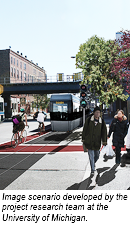U.S. Department of Transportation
Federal Highway Administration
1200 New Jersey Avenue, SE
Washington, DC 20590
202-366-4000
Federal Highway Administration Research and Technology
Coordinating, Developing, and Delivering Highway Transportation Innovations
| FACT SHEET |
| This fact sheet is an archived publication and may contain dated technical, contact, and link information |
| Publication Number: FHWA-HRT-14-046 Date: February 2014 |
Publication Number: FHWA-HRT-14-046 Date: February 2014 |
 |
The Exploratory Advanced Research Program Fact SheetExploratory Advanced Research . . . Next Generation Transportation Solutions |

A transit system capable of taking travelers all the way from their point of origin to their final destination could revolutionize transit use. “Effects of Automated Transit and Pedestrian/Bicycling Facilities on Urban Travel Patterns,” is a Federal Highway Administration (FHWA) Exploratory Advanced Research (EAR) Program study, awarded to the University of Michigan, aimed at assessing the demand for an innovative transit shuttle service using automated vehicles. |
Addressing Transit Problems
The need to deliver travelers all the way from their point of origin to their destination is a common transit problem in the United States. Known as the last mile, the problem is thought to deter transit use among riders with auto access, even when high-quality transit service is provided for the majority of the trip distance.
This study examines whether an automated community shuttle service would encourage drivers to shift transportation mode. The research explores demand for a high-frequency shuttle service, operating every few minutes, between homes and regional transit access points. Additionally, several other factors that could encourage drivers to shift commute modes are examined as part of this study. These include bike lanes, walkway improvements, and other community amenities designed to improve the quality of the community environment and attract drivers to walk and bike to the regional transit access points.
The major challenge of this study was to analyze the potential use of a new type of transit service. Since the service does not yet exist, there was no prior experience directly applicable. The project team chose to develop new transportation demand models and a corresponding innovative data collection approach that could elicit people’s opinions about a transit service that they had never experienced.
Data Collection
The study focused on four neighborhoods in metropolitan Chicago, IL, an area with a significant regional rapid transit network and room to grow further in terms of transit use. The neighborhoods all had similar access to the Chicago Transportation Authority (CTA) elevated and subway system but represented significantly different combinations of affluence and density. For example, Evanston was chosen for its higher income and higher density; Skokie was chosen for its higher income but lower density; Pilsen was chosen for its lower income and higher density; and Cicero was chosen for its lower income and lower density.
Conducting Surveys
Over 150 households were surveyed in each of these Chicago neighborhoods, with all respondents living within 1.5 mi (2.4 km) of a CTA rapid transit station and working within 3 mi (4.8 km) of a station. The survey was designed to incorporate current travel patterns and a respondent’s stated preference after a hypothetical implementation of the improvements was described to them utilizing text and imaginative graphics based upon photographs of their own neighborhood. The service was described in functional terms only and centered on the frequency of arrivals to avoid any adverse reactions to the unfamiliar concept of an automated transit shuttle service. This survey was used as the basis of estimation of an activity-based model of mode choice in the areas studied.
Modeling Commuters
An agent-based model was used to represent the commuters and their preferences for different aspects of transportation—primarily cost, time, and safety. Commuters within the model assess their transportation options in light of their preferences, the characteristics of the environments, and the various modes available to them. The model was calibrated with data from the four neighborhoods and implemented on a stylized version of each neighborhood. Parameters from the activity-based model were incorporated into the agent-based model and simulations were run on the basis of this combined model.
Simulation Results
The transportation mode choices were modeled with and without neighborhood shuttles and a set of urban amenities. Results showed that deploying the neighborhood shuttle in combination with bike lanes reduced driving up to 52 percent, predominantly in the more auto-orientated neighborhoods of Cicero and Skokie. Auto-use reductions were shown to be lower in areas with greater transit use to begin with, specifically Pilsen and Evanston. Train use increased up to 117 percent, predominantly in Skokie and Cicero. Overall results suggested that community transit could decrease car share from 36 to 22 percent across all the neighborhoods and increase CTA rapid transit share from 50 to 67 percent of these trips.
Further Investigation
Further research is needed to refine the models and eventually replicate the study in other communities and situations, including areas farther than 1.5 mi (2.4 km) from regional transit access points. Additionally, field tests of community shuttle services would be needed in multiple communities to validate the demand shifts predicted by the models in this initial study.
“This study enables us to assess the demand for an innovative transit shuttle service that could possibly be established through the use of automated vehicles,” explains Robert Ferlis at FHWA. “Such a system could lead to a dramatic change in transportation commuting patterns, specifically moving from driving to transit use.”
Learn More
For more information on the University of Michigan project, contact Robert Ferlis at FHWA, 202-493-3268
(email: robert.ferlis@dot.gov).
|
What Is the Exploratory Advanced Research Program? FHWA’s Exploratory Advanced Research (EAR) Program focuses on long-term, high-risk research with a high payoff potential. The program addresses underlying gaps faced by applied highway research programs, anticipates emerging issues with national implications, and reflects broad transportation industry goals and objectives. To learn more about the EAR Program, visit the Exploratory Advanced Research Web site at www.fhwa.dot.gov/advancedresearch. The site features information on research solicitations, updates on ongoing research, links to published materials, summaries of past EAR Program events, and details on upcoming events. For additional information, contact David Kuehn at FHWA, 202-493-3414 (email: david.kuehn@dot.gov), or Terry Halkyard at FHWA, 202-493-3467 (email: terry.halkyard@dot.gov). |
Publication No.
FHWA-HRT-14-046
HRTM-30/02-14(1M)E